Building a Barbecue Grill: A Complete Guide
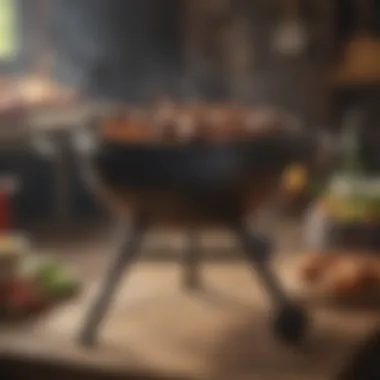
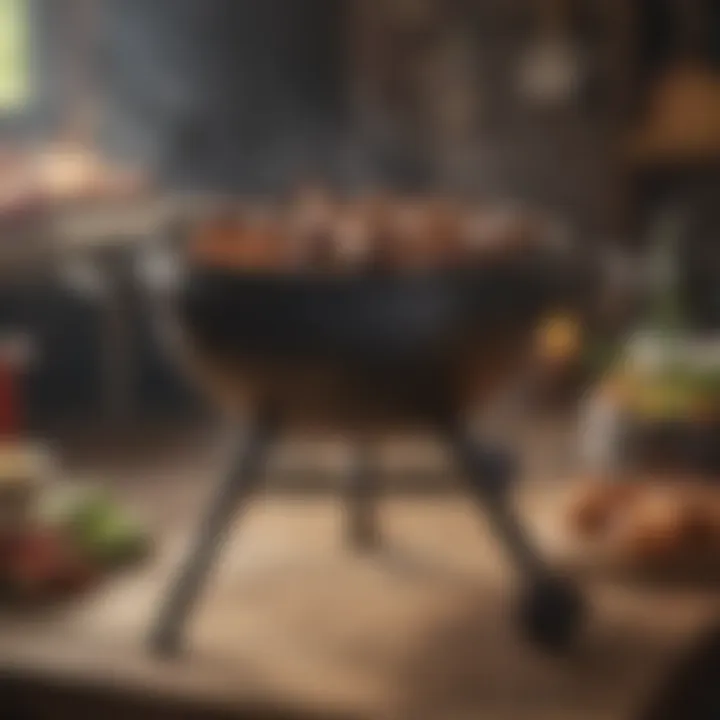
Intro
Constructing a barbecue grill may seem like an overwhelming task, but it is an enriching experience that allows one to enjoy outdoor cooking. This guide will cover the essentials that you need to know before embarking on this project. From selecting the right materials to mastering grilling techniques, you will find valuable information tailored for both novices and seasoned grill enthusiasts.
Understanding the components of a grill and their functions makes the entire assembly process easier. A grill consists of several key parts: the firebox, cooking grate, ignition system, and the exterior body. Each plays a pivotal role in how heat is generated, distributed, and maintained.
Safety is also a primary consideration when building your own grill. Working with tools can be risky, and knowing how to operate them properly will keep injuries at bay. Post construction, maintaining the grill ensures it serves its purpose well.
Throughout this guide, various grilling methods, tips about equipment, and essential maintenance practices will be discussed. By the end, you will be equipped to build a dependable barbecue grill that meets your cooking needs and preferences. Let's dive into the process of bringing the grill of your dreams to life.
Prelims to Building a Barbecue Grill
Constructing your own barbecue grill can be both a practical and rewarding endeavor. It offers the flexibility to customize the design according to your needs. Understanding what goes into building a grill is essential. It is not just about assembling materials; it involves thoughtful planning and choices. This article addresses key components that form the core of a successful grill project.
Why Build Your Own Grill
There are numerous reasons for opting to build a barbecue grill. Firstly, it allows for customization. You can design the grill to suit your cooking preferences or the specific space in your backyard. This means you can choose the size, style, and features that fit your needs perfectly.
Additionally, building your own grill can be more economical than purchasing a pre-made model. High-quality commercial grills often come with a hefty price tag. By selecting the materials personally and managing the design, you may save not just money, but also gain satisfaction from your unique creation.
Lastly, constructing your grill provides an opportunity to learn about the different components that contribute to effective grilling. From understanding how heat distribution works to exploring various fuel sources, each element can enhance your grilling skills.
Understanding Grill Types
Grills are primarily categorized by their fuel type. Each type has distinct characteristics that impact cooking results and user experience. Familiarity with these types guides you in selecting the option that aligns best with your cooking habits.
Charcoal Grills: These grills typically offer a smoky flavor that many grilling enthusiasts cherish. The primary challenge lies in controlling temperature, as charcoal requires practice to master.
Gas Grills: Propane or natural gas-powered grills provide convenience and quick heating. They offer better temperature control than charcoal, making them suitable for those who prioritize ease of use.
Electric Grills: Ideal for those with limited outdoor space, electric grills can be used indoors. However, they do not impart the same flavor profile as charcoal or gas.
Each type also comes with variations, like portable models or built-in options. Understanding these will pave way for a more informed choice when you start the building process.
Materials Needed
In the endeavor of constructing a barbecue grill, selecting the right materials is paramount. The materials you use not only determine the durability and efficiency of the grill but also affect the overall grilling experience. This section will outline essential components, the types of materials suitable for grill bodies, fuel sources available, and key components that contribute to a successful build.
Grill Body Materials
Metal Options
Metal is a popular choice for barbecue grill bodies due to its strength and heat retention qualities. Stainless steel is often favored for its rust resistance and ease of cleaning. Additionally, it offers a sleek appearance that many grill enthusiasts appreciate. However, carbon steel can also be a viable option. It conducts heat effectively, which can enhance cooking performance. The downside of carbon steel is its susceptibility to rust if not properly maintained.
Overall, metals provide durability, and with proper care, they can last many years.
Ceramic Considerations
Ceramic materials exhibit excellent heat retention and distribution. This makes them ideal for slow cooking and smoking applications. Furthermore, ceramics can handle high temperatures, leading to a unique grilling experience. However, the fragility of ceramic means they require careful handling during construction and usage. Although they may not be as durable as metal, their ability to impart flavors can be a significant advantage in a custom grill build.
Fuel Sources
Charcoal vs. Gas
When it comes to fuel sources for your grill, the choice between charcoal and gas often sparks debate among grill enthusiasts. Charcoal produces a distinct flavor and can reach higher temperatures, making it suitable for searing meats. On the other hand, gas grills offer convenience through easy ignition and adjustable heat control. Ultimately, the choice hinges on personal preference and desired grilling techniques. Each has its unique benefits, with charcoal being traditionally favored for flavor, while gas excels in convenience.
Wood Chips and Pellets
Incorporating wood chips or pellets into your grilling can significantly enhance the flavor profile of dishes. Different types of wood impart various flavors, such as hickory for a strong smokiness or apple for a milder sweetness. These options allow for greater customization of taste and can turn ordinary meals into flavorful creations. However, they often require specific setups, such as smoke boxes, to function effectively.
Essential Components
Grates
Grates are fundamental in determining the cooking quality of your grill. They can be made from stainless steel, cast iron, or porcelain-coated materials. Cast iron grates excel at heat retention, promoting excellent searing. However, they can be heavy and require maintenance to prevent rusting. Stainless steel, while lighter and rust resistant, may not hold heat as well. Ultimately, the choice of grates should align with your cooking style and desired food texture.
Burners
Burners are a crucial component of gas grills, contributing to the heat source. High-quality burners made from stainless steel or brass offer superior durability and heat distribution. Having multi-zone burners allows for versatile cooking options such as direct and indirect grilling. Selecting the right burner type ensures efficient fuel usage and consistent temperature management.
Smoke Boxes
Smoke boxes enhance the grilling experience by allowing the use of wood chips to produce smoke. They help impart complex flavors to meats and vegetables. Smoke boxes can be found as standalone units or integrated into certain grill designs. It is crucial to ensure the smoke box is compatible with your grill type to maximize functionality and flavor outcomes.
Key Takeaway: Selecting the right materials and components directly influences the success of your barbecue grill build. Each aspect holds weight in achieving a satisfying grilling experience.
Tools Required
In constructing a barbecue grill, the selection of proper tools is crucial. The right tools not only facilitate the building process but also ensure precision and safety. When embarking on such a project, understanding the tools required can enhance the overall experience and the final outcome. Using suitable tools can lead to better efficiency and reduced mistakes, making the construction of a grill more enjoyable.
Basic Hand Tools
Basic hand tools are the foundation of any grill-building project. They are essential for various tasks that require manual skill and can be useful in a wide range of other home projects as well.
Screwdrivers
Screwdrivers hold significant importance during assembly. They are invaluable for attaching various parts of the grill securely. The key characteristic of screwdrivers is their versatility. They come in different sizes and types, such as Phillips and flathead, which allows them to accommodate various screw designs. This variety makes screwdrivers a beneficial choice for this project.
The unique feature of screwdrivers is their ability to offer precise control in tight spaces, ensuring that screws can be fastened tightly without damaging surfaces. However, the primary disadvantage is that they require manual effort and can be slow compared to power tools.
Wrenches
Wrenches are another critical tool in this endeavor. They are specifically designed for gripping and turning nuts and bolts. The key characteristic of wrenches is their ability to provide leverage, which aids in loosening or tightening fasteners securely. This makes them a popular choice when building a grill, as many parts are held together by bolts.
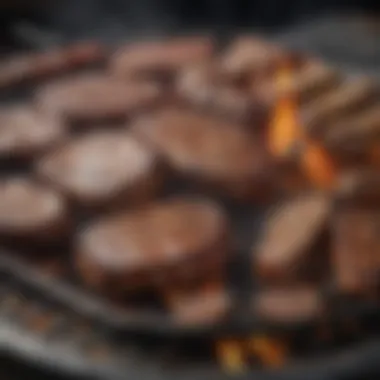
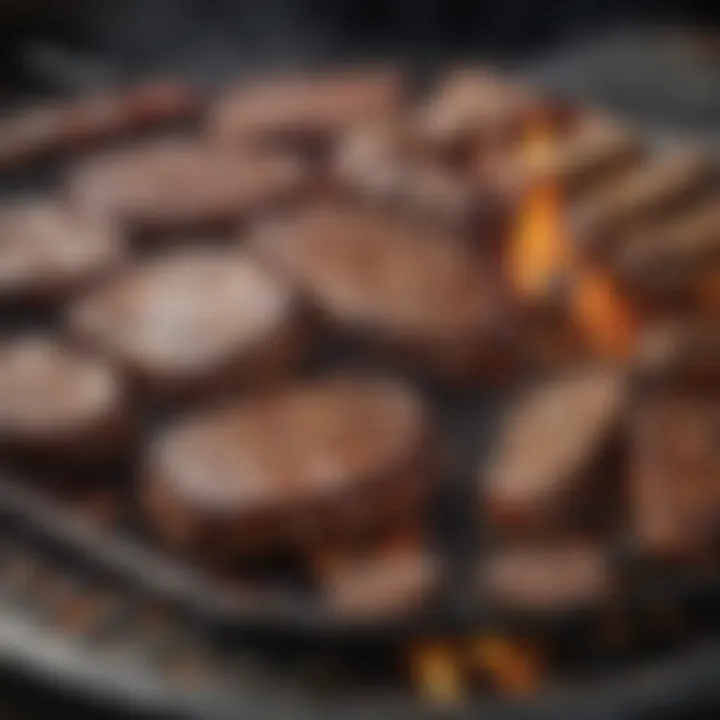
One notable feature of wrenches is their ability to fit into confined areas where other tools might not reach, allowing for versatile use. However, if not used with caution, there is a risk of stripping bolts which can lead to further issues.
Hammers
Hammers are essential for tasks that require a more forceful approach. They can drive nails, adjust parts, or even break apart materials. The key characteristic of hammers is their straightforward mechanism: they transfer force directly to an object. This makes them a beneficial tool for building tasks where alignment and secure joining are essential.
A unique advantage of hammers is their ability to quickly make adjustments to ill-fitting pieces. On the downside, improper use can result in bent materials or damage to the components being assembled.
Power Tools
Power tools make the building process more efficient. They enable users to complete tasks faster and often with more precision than hand tools alone.
Drills
Drills hold a pivotal role in the assembly of a barbecue grill. They are used for creating holes or driving screws faster than hand tools. The key characteristic of drills is their power-driven mechanism. This allows users to perform repetitive tasks with ease, making them an essential tool for the project.
One unique feature of drills is their ability to use various attachments, which increases their functional range. However, a disadvantage is the need for proper handling; misuse can lead to damage or injuries.
Saw Recommendations
Saws are indispensable for cutting materials to size, especially when working with wood for grill construction. The key characteristic of saws is their cutting blade, which allows for precise trims and modifications. For this guide, both circular saws and jigsaws are recommended due to their versatility.
The unique feature of saws is their ability to produce various cuts, enhancing design options. However, like other power tools, they come with safety risks. Proper training and safety gear are essential while using these tools to prevent accidents.
Planning Your Build
Planning is a crucial phase when building your barbecue grill. It defines the scope of your project and sets the tone for what to expect. Without an effective plan, you might face challenges that can range from assembling the grill in the wrong order to finding that your design does not meet your cooking needs. Therefore, it is beneficial to take adequate time to think through your design considerations. This step can saves you time and resources in the long run.
Design Considerations
Size and Capacity
The size and capacity of your barbecue grill are vital. They determine how much food you can cook at once and how the grill will fit in your outdoor space. A larger grill may be suitable for frequent gatherings or parties, while a smaller one works well for casual family meals. The key aspect here is ensuring that the grill aligns with your cooking habits and available space. This is important because a grill that is too small could limit your cooking options, whereas one that is too large may become unwieldy and difficult to manage.
A unique feature of considering size is that it encourages thought into the layout of your outdoor cooking area. For example, a bigger grill may require more fuel and maintenance. But in return, it allows you to cook larger portions efficiently. In contrast, smaller grills are often more economical and easier to clean, making them appealing options.
Portability
Portability is another essential consideration. It refers to how easy it is to move the grill. If you plan to frequently change your grill's location or transport it to various venues, portability becomes crucial. Grills that are lightweight and equipped with wheels enable easy relocation, enhancing their usability.
A key characteristic of portable grills is their compact design. These designs allow for taking the grill along to picnics or camping trips. However, many portable grills may have limited cooking surface area, which can be a disadvantage if you frequently cook for larger groups. Thus, weighing the importance of portability against your cooking needs is necessary when planning your build.
Creating a Blueprint
Creating a blueprint is an effective way to visualize the final product. This stage involves laying out how the grill will look and function. A well-crafted blueprint provides guidelines and helps maintain focus during the building process. This ensures that things move smoothly as you start assembling parts.
Sketching Your Design
Sketching your design is a practical step. It allows you to capture ideas on paper. Through sketching, you specify design elements and configurations that fit your aesthetic preference and functional needs. A well-thought-out sketch serves as a reference point during assembly, keeping everything organized.
The advantage of sketching lies in its simplicity and accessibility. It requires no special software or advanced skills. However, your sketches may lack precision if not done carefully. It is important, therefore, to take time and pay attention to detail here.
Choosing Dimensions
Finally, choosing dimensions plays a critical role in the planning stage. It reflects how each part of the grill will fit together and impacts ease of use and efficiency. This includes measurements for the grill surface, height, and storage areas.
Key aspects of choosing dimensions include ensuring that they are conducive to the space you have available. Thoughtful dimension choices can maximize cooking efficiency and comfort when using the grill. However, improper dimensions may lead to difficulties such as awkward handling or reduced cooking capacity.
Planning your grill build carefully means putting thought into these considerations. With a well-planned approach, assembling a barbecue grill becomes much more manageable and ultimately satisfying.
Assembling the Grill
Assembling a barbecue grill is a fundamental step in the entire building process. This phase lays the groundwork for how your grill will perform in the long run. Attention to detail during assembly ensures a sturdy and functional end product. The key elements to consider are the frame, grilling surface, and the finishing touches that enhance usability.
Building the Frame
Base and Stand Construction
The base and stand construction serves as the foundation of your grill. It comprises various materials that hold the weight and withstand the grilling process. The main characteristic of a well-constructed base is its stability, which is critical in preventing accidents during cooking. A popular choice is to use heavy-duty steel or aluminum, as they offer durability and resistance to high temperatures. One unique feature is the height of the stand; choosing a comfortable height can significantly enhance your grilling experience. However, if the stand is too low or high, it can lead to discomfort during use.
Securing the Structure
Securing the structure is vital for ensuring that all components of the grill function together safely and efficiently. The key characteristic here is the use of bolts and brackets that prevent movement during use. Properly securing the grill adds to its longevity and safety. A unique aspect of this method is that it allows for easy disassembly should any repairs or adjustments be needed in the future. However, the downside can be the initial complexity; inexperienced builders may find it challenging to navigate the instructions for securing their structure properly.
Installing the Grilling Surface
Positioning Grates
Positioning grates is crucial for achieving the desired grilling results. The specific aspect revolves around proper spacing and height. Great positioning affects heat distribution and cooking efficiency. The ideal characteristic of grates is their material, often made from cast iron or stainless steel, which promotes even cooking. A notable feature is the adjustable height of some grates, which allows users to achieve specific cooking preferences. However, if not positioned correctly, they can lead to uneven cooking or food falling through.
Setting Up Burners
Setting up burners is essential for controlling heat and cooking methods. The specific aspect involves selecting the appropriate burner type based on fuel choice, such as gas or charcoal. A key characteristic of well-arranged burners is their arrangement for consistent heat across the grilling surface. This choice is beneficial because it can greatly enhance the flavor of the food cooked. A unique feature some models offer is adjustable burners, which enable different heat levels for various cooking requirements. Nonetheless, there may be disadvantages, such as increased complexity in setup and potential for malfunction if improperly installed.
Finishing Touches
Adding Shelves
Adding shelves to your grill can make a significant difference in usability. The specific aspect here includes functionality and convenience during grilling. A key characteristic of shelves is the availability of extra space for seasoning and utensils, enhancing the cooking experience. They are particularly beneficial because they keep everything you need within reach. A unique feature possible with shelves is foldable designs that save space when not in use. However, the potential downside could be the added weight to the grill, making transportation a bit more challenging.
Painting and Coating
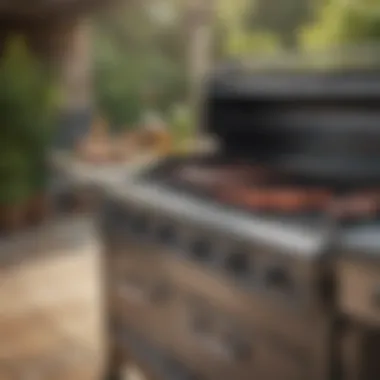
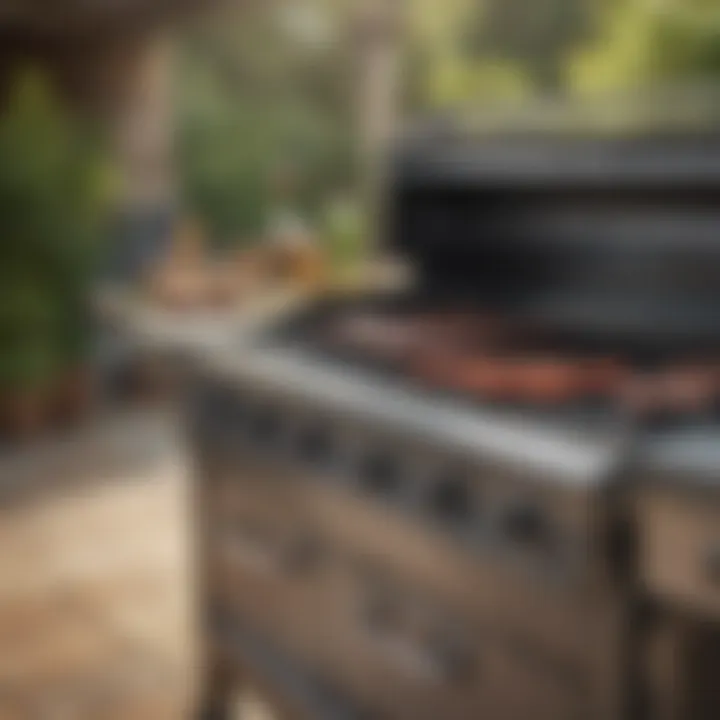
Painting and coating your grill is not just about aesthetics; it plays a role in protection. The specific aspect is the choice of weather-resistant paint or high-heat coatings that can withstand outdoor elements. A key characteristic of these coatings is their ability to prevent rust and other forms of degradation. A comprehensive coating enhances the durability of the grill, thus leading to longevity. Some unique features include finishes that can provide additional grill cleaning ease. The disadvantages might include the requirement for reapplication over time.
Safety Precautions
Safety is paramount when building and using a barbecue grill. It minimizes risks and ensures a smooth experience when grilling. Understanding safety precautions can help you avoid accidents that lead to injuries or property damage. Awareness of the tools and fuel used can elevate your confidence in both building and utilizing your grill.
Working with Tools
When assembling your barbecue grill, using the right tools safely is critical. Each tool has its own risks, and knowing how to handle them properly can prevent accidents.
Personal Protective Equipment
Personal Protective Equipment (PPE) is essential in any grill-building endeavor. This includes safety glasses, gloves, and dust masks, which protect against debris and sharp tools. The principle of using PPE is straightforward — it safeguards your health. A key characteristic is that it provides a barrier between you and potential hazards. This makes it a popular choice in the building process. For instance, safety glasses can shield your eyes from metal shards when cutting or grinding materials. However, ensuring you are comfortable wearing PPE is vital, as neglecting it can lead to serious injuries.
Tool Safety Practices
Adhering to proper tool safety practices is integral when using various equipment during your grill's construction. This includes keeping tools in good condition, reading manuals, and following operational guidelines. Such practices enhance the safety of all building operations, making it a beneficial choice for both novice and experienced builders. A unique feature of these practices is regular maintenance checks on power tools. Neglecting these checks can result in malfunctions that may cause injury or delay in the project.
Fire Safety Considerations
Fire hazards are not to be underestimated when building a grill. Taking precautions is essential in preventing accidents that can have significant repercussions.
Proper Fuel Storage
Proper fuel storage is a significant aspect when dealing with charcoal or gas. Storing fuels in appropriate containers minimizes the risk of leaks or accidents. A key characteristic of proper fuel storage is keeping the fuel in a dry, cool location away from direct sunlight. This is a beneficial practice for the grill-building process. Proper storage is not just about convenience; it’s also about safety. Failing to store fuel correctly can lead to hazardous situations, especially with volatile substances like propane.
Emergency Preparedness
Being prepared for emergencies is vital in ensuring safety during the grilling process. This includes having a fire extinguisher nearby and knowing how to use it. Emergency Preparedness promotes quick reactions to fires or accidents, making it a crucial part of the grilling experience. A unique aspect of this is having an emergency plan in place. This can range from familiarizing family members with safety protocols to ensuring first-aid kits are accessible. Without proper planning, panic can ensue, worsening the situation.
Maintaining Your Grill
Maintaining your grill is crucial for its longevity and performance. Regular care ensures that your barbecue remains in optimal working condition, delivering great results each time you cook. A well-maintained grill also enhances food safety, as accumulated grease and debris can lead to flare-ups or unpleasant flavors in the food. Additionally, with proper maintenance, you can save on replacement costs for parts or even a new grill altogether. Overall, making time for maintenance will greatly enrich your outdoor cooking experience.
Regular Cleaning Routines
Cleaning Grates
Cleaning grates is a fundamental aspect of grill maintenance. It is essential for both hygiene and flavor. After each use, food residue can build up, potentially affecting the taste of the next meal cooked. A clean grate ensures better heat distribution. One popular method is using a wire grill brush while the grates are still warm. This fact provides a quick and effective way to remove stuck-on bits.
The key characteristic of cleaning grates is its simplicity. Using minimal tools and effort can pay off in the effectiveness. It is also a beneficial choice because it helps in avoiding cross-contamination of flavors. However, using the wrong tools can scratch the grate surface. Hence, it is wise to select brushes specifically designed for your grate material.
Inspecting Components
Inspecting components is another critical routine that plays a significant role in the maintenance of your grill. Regular checks can identify potential issues before they escalate. This includes looking over burners, hoses, and knobs for wear or damage. Noticing these faults early allows for repairs or replacements before grilling season begins.
The key characteristic of inspecting components is its preventative nature. This routine saves time and money by avoiding significant repairs. It offers peace of mind when preparing meals outdoors. One unique feature of this process is that it provides an opportunity to become familiar with your grill’s setup and function. However, neglecting these checks could lead to dangerous situations during cooking.
Long-Term Care
Covering and Storing
Covering and storing your grill properly can extend its life significantly. This aspect ensures it is protected from harsh weather conditions, dirt, and pests. A good-quality cover will prevent rusting and fading from UV exposure. Making a habit of covering the grill after each use can save you from time-consuming cleaning sessions later.
The key characteristic of covering and storing is its simplicity. Using a cover is easy and an overlooked effective method for long-term care. However, not all covers are created equal. Ensure the cover fits well and is made from durable materials to withstand the elements.
Annual Maintenance Checks
Annual maintenance checks are vital for long-term grill health. This involves deeper cleaning processes and assessments, such as inspecting propane tanks or gas lines, and ensuring all connections are secure. Completing this step before putting your grill to use for the season can significantly enhance safety and performance.
The key feature of annual maintenance checks is the level of detail they involve. This routine allows the owner to deep dive into potential issues overlooked during routine cleaning. It is beneficial as it establishes a comprehensive understanding of the grill’s condition. However, this step requires a bit more time and effort compared to regular maintenance. For instance, if issues are discovered, they must be addressed with either replacement parts or professional help.
Mastering Grilling Techniques
Grilling is an art, and mastering the techniques essential for it elevates not just the food but the entire cooking experience. Various methods exist to achieve desired flavors and textures, and understanding them can greatly benefit your outdoor cooking. Different techniques create distinctive outcomes in terms of taste and doneness, allowing for versatility in meal preparations. As you enhance your skills, you will find that the nuances of grilling contribute to improved enjoyment of your culinary endeavors.
Direct Grilling Methods
Direct grilling involves placing the food directly over the heat source. This method is often chosen for its speed and efficiency, making it popular among enthusiasts and casual cooks alike.
High Heat Techniques
High heat grilling is characterized by cooking food at temperatures above 450°F. This technique allows for quick cooking and is ideal for searing meats, creating a nice crust while locking in juices. The key characteristic of using high heat is the ability to achieve a charred exterior while maintaining tenderness inside. This method is beneficial in that it reduces cooking time significantly, making it an attractive option for busy cooks.
However, it requires close attention to avoid burning, which is a common disadvantage. Strong heat can be tricky, especially when grilling thicker cuts of meat. Thus, managing time effectively is crucial during high heat grilling.
Ideal Foods for Direct Heat
When using direct heat, certain foods perform better than others. Generally, thinner cuts of meat, vegetables, and items that benefit from a good sear, like steaks or burgers, are preferred. These foods cook quickly, thus retaining moisture and flavor under direct heat.
The standout feature of direct grilling is the quick caramelization and the delightful grill marks that enhance presentation. This method is often seen as a compelling choice due to its effectiveness in producing dishes that are juicy and flavorful. Yet, not all items are suitable for this method, as delicate proteins may cook unevenly or dry out.
Indirect Grilling Methods
Indirect grilling is another approach where food is placed next to the heat source rather than directly above it. This method is essential for larger cuts of meat requiring longer cooking times, allowing for more controlled cooking conditions.
Setting Up Zones
Setting up zones involves creating areas of direct and indirect heat on the grill. This method provides versatility, allowing for many cooking techniques simultaneously. For instance, you can sear a steak over high heat and then move it to the cooler part of the grill to finish cooking slowly.
The primary characteristic of zone cooking is adaptability. It encourages cooks to manage their grilling effectively. This method can be a beneficial choice as it accommodates various types of food, ensuring even cooking while preventing charring on delicate items. However, zone setup may require some practice to become proficient.
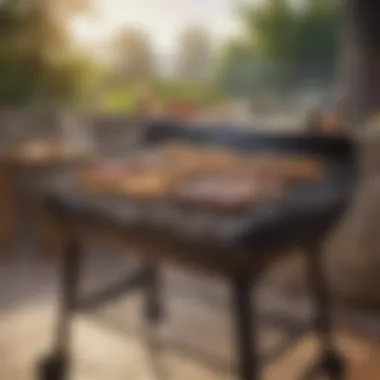
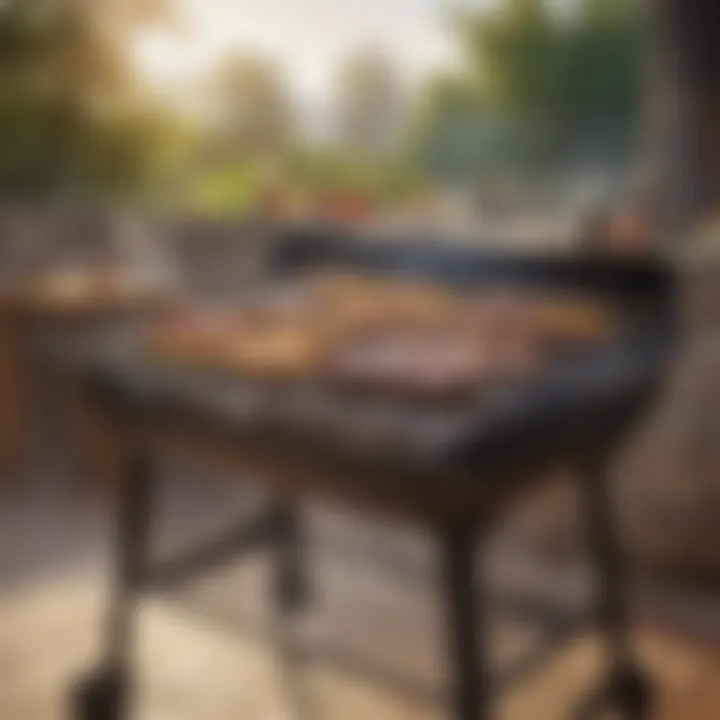
Benefits of Indirect Grilling
Indirect grilling has multiple benefits, the most prominent being the thermal control it provides. This technique allows for slow and low cooking, perfect for larger cuts such as whole chickens or ribs, enhancing tenderness and flavor.
The unique feature of this method includes the ability to utilize smoke and marinades effectively, infusing meat with deep flavors over time. Given its lower heat levels, the risk of burning is reduced, which can be an asset for less experienced cooks. Yet, the disadvantage means longer cooking times compared to direct methods, which may pose a challenge when time is limited.
Understanding these grilling techniques is essential for maximizing flavor and cooking success. It's crucial to explore each method in practice to see what fits best with your cooking style.
Exploring Flavor Enhancements
When diving into the realm of grilling, flavor enhancements play a crucial role in transforming basic grilled food into succulent masterpieces. Various techniques for seasoning and smoking elevate the grilling experience significantly. Understanding these methods will enable you to craft dishes that not only satisfy hunger but also tantalize the palate. This section focuses on two primary aspects: marinades and rubs, as well as smoking techniques.
Marinades and Rubs
Creating Your Own Recipes
Creating your own marinades and rubs allows for a personalized touch in flavor. This process is essential as it can be tailored to your taste preferences, dietary needs, or even seasonal ingredients. Making your own recipes means you control the quality and balance of flavors, which is a major advantage.
The key characteristic of creating your own recipes is the ability to experiment freely. Home cooks can blend spices, herbs, and liquids to craft unique profiles. This offers a chance to explore culinary creativity, matching flavors with specific meats or vegetables. The unique feature of this approach is that it can be adjusted based on past experiences or desired outcomes, leading to continuous improvement in grilling skills. However, it may take time to achieve the perfect balance that excites the palate.
Tips for Efficient Use
Efficient use of marinades and rubs is vital for maximizing flavor impact without overwhelming the dish. One primary focus is on the timing of application. For instance, shorter marinating times can be effective with certain proteins, while others benefit from longer soaking periods. Knowing when to apply these flavor enhancers contributes to improved cooking results.
The key characteristic here is the notion of resting time. Allowing marinades to penetrate the meat properly can lead to better texture and taste. Another point to consider is the balance of ingredients; it's essential to avoid overpowering flavors. On the downside, improper application can sometimes lead to mushy textures or an unappealing taste.
Smoking Techniques
Choosing Wood Types
Selecting the right wood for smoking is foundational to achieving the desired flavor profile. Each type of wood imparts distinct flavors that can complement or enhance the natural tastes of your food. For example, hickory is known for its strong, smoky flavor, while apple wood offers a sweeter, milder essence.
A key characteristic of choosing wood types is how it interacts with different meats. Certain woods pair better with specific proteins. Oak, for example, is versatile and works well with most meats. The unique feature of this process is that it opens up a world of flavor possibilities, making it easy to create a signature grilling style. The downside can be the learning curve in understanding which wood pairs best with which dish, as not all combinations will yield favorable results.
Enhancing Flavor Profiles
Enhancing flavor profiles through smoking involves more than just the choice of wood. Techniques such as temperature control and smoke density play significant roles. These factors influence how the smoke permeates your food, creating layers of complex flavors.
The key characteristic of this technique is consistency. Maintaining a steady temperature while adding wood chips at the right time is essential for achieving that rich, smoky flavor without overdrying the food. Additionally, using a combination of methods, like wrapping meats in foil during the smoking process, can deeply infuse flavor while keeping the dish tender. However, finding that balance can take practice, and mastering it can lead to impressive flavor experiences.
"Flavor enhancements through proper seasoning and smoking are not optional; they are a necessity for an exceptional grilling experience."
Common Mistakes to Avoid
Building a barbecue grill can be rewarding. However, many enthusiasts overlook critical details that can affect their grilling experience. Avoiding common mistakes enhances both the process and the final result. By recognizing pitfalls, builders can save time and effort, preventing frustration down the road. Let's explore these mistakes in depth.
Underestimating Preparation Time
One of the most significant missteps in building a barbecue grill is underestimating preparation time. Many assume they can complete the project quickly. However, careful planning is essential. Preparing materials, acquiring tools, and designing a blueprint take time.
- Gathering Supplies: Take the time to list out what is needed and purchase them in advance. Check for any missing items before you start.
- Setting Aside Time: Allocate a realistic amount of hours to finish the project. Many find themselves rushing at the end, leading to errors.
"Preparation is key. Without enough time set aside, important steps may be overlooked that can hinder the final result."
Proper preparation prevents mistakes and ensures that the building process is smooth. By recognizing the value of this phase, you can build your grill with greater confidence.
Ignoring Safety Protocols
Safety cannot be neglected while building a grill. Ignoring safety precautions can lead to injuries and accidents. Familiarize yourself with basic safety protocols before starting.
- Personal Protective Equipment: Always use gloves, goggles, and a mask if necessary. Protect yourself from sharp objects and fumes.
- Tool Safety Practices: Ensure that all tools are in proper working condition. Mismanaged tools can not only lead to mistakes but serious injuries.
Understanding safety procedures before engaging in the build minimizes risk. Protecting oneself should be a primer concern. Following guidelines will lead to safer practices and better outcomes.
Mismanaging Heat Levels
When the grill is finally assembled, controlling heat becomes crucial. Mismanaging heat levels can ruin food and waste fuel. It can also damage components within the grill.
- Temperature Awareness: Familiarize yourself with the necessary heat levels for different foods. Different meats and vegetables require varying degrees of heat during cooking.
- Zone Control: Create zones for high and low heat to offer better cooking options. This will help in avoiding burnt food or undercooked dishes.
Effective heat management enhances outcomes while grilling. It is essential to monitor the temperature constantly to ensure optimal results. Mismanagement may lead to disappointing meals and wasted ingredients.
Finale
Building your own barbecue grill is not just a project; it is a journey that culminates in a tangible reward: an enhanced outdoor cooking experience. As we have explored throughout this article, creating a grill involves understanding the types of grills, selecting appropriate materials, and knowing the essential tools required for the job. Moreover, the assembly process, while meticulous, is straightforward for anyone prepared to invest time and effort.
Reflecting on the Build Process
Reflecting on the build process reveals the numerous benefits it offers. First, the sense of accomplishment that accompanies constructing a grill can greatly enhance your enjoyment of outdoor cooking. You learn about the functionality of different components and how they interact during grilling. This knowledge enables you to troubleshoot issues that may arise in the future, fostering a deeper relationship with your grill.
Additionally, the customizability of a self-built grill cannot be overstated. You determine size, materials, and features. These choices reflect personal preferences and cooking styles, helping to create an outdoor focal point that is uniquely yours.
Lastly, building a barbecue grill also serves as a practical exercise in planning and organization. Each step requires thought, from choosing the right dimensions to ensuring safety practices are followed. This organized approach not only benefits the grill project but also translates to other DIY endeavors.
Encouragement for Further Experimentation
Taking the leap to build a barbecue grill opens many avenues for culinary exploration. The insights gained from your initial grilling experience offer a foundation upon which to experiment with flavors, techniques, and even modifications to the grill itself. Perhaps you will want to integrate a rotisserie feature or explore ceramic cooking options. Moreover, trying new recipes can enhance your confidence in outdoor cooking.
The discussion of flavor enhancements, like marinades and smoking techniques, merely scratches the surface. Dive deeper into combinations of herbs and spices, or explore regional grilling styles from around the world. Share your findings with friends and family; each experiment can foster connections.
Embrace the journey of outdoor cooking. Each grill mark tells a story, and every meal shared can become a cherished memory.
By embarking on this path, you elevate your barbecuing skills and create lasting culinary experiences.







